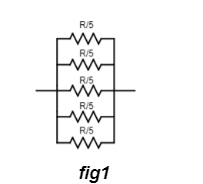Question
Question: A piece of wire is cut into 5 equal parts. They are the connected parallel. If the equivalent resist...
A piece of wire is cut into 5 equal parts. They are the connected parallel. If the equivalent resistance of this combination is R’, then the ratio R′R is?
Solution
Hint: Resistance is proportional to the length of wire and connecting n resistors parallel reduces the resistance n1 times.
Formula used: R=Aρl ; Reff1=R11+R21+...+Rn1
Complete step by step answer:
We know the resistance of a wire is proportional to the length of the wire (∵R=Aρl)
Let’s say the total resistance of the wire before cutting wasR.
When we cut the wire into 5 parts, each one has a length of 5l and all other parameters remain unchanged.
So the resistance of each new segment is5R.
Connecting them parallel gives a network as shown in fig1.

Now since the question asks for The effective resistance of this combination, lets recollect that the effective resistance of a parallel combination of n resistances - R1,R2,R3, . . . Rn is given by: Reff1=R11+R21+...+Rn1
So if R′ is the resistance of this new combination, then:
R′1=5R1+5R1+5R1+5R1+5R1
Simplifying this expression a bit gives us:
R′1=5R5
R′=25R
So the ratio R′R=25 , which is the required answer.
Additional Information:
Here the wire was cut and hence the area remained constant. In cases where wire is stretched to a new length, resistance is not proportional to length.
In cases of stretching, since its volume V that is conserved, The Resistance R can be related with length l as R=Aρl=A×lρl×l=Vρl2.
Thus in case of stretching, the resistance varies as R∝l2
Note: We can answer this question quicker by remembering some special cases in parallel. When we have n equal resistances each of resistance R connected parallel, the effective resistance becomes nR.
Here since we have 5 resistances, each of Resistance 5R
R′=55R=25R
So R′R=25
